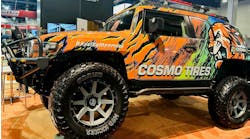Last month we discussed the rapid growth of complexity in the consumer tire market along with the methods to research important new products as well as review your current product assortment. If you put in the considerable time it takes to research and review you have most likely discovered sizes, SKUs and new treads that should be added to your product screen.
You are off to a good start, but the hard work of discovery is only one step on the path to taming wild SKU proliferation. To set these new products up for controlled growth in your future product plan, the second step of implementation is even more important. This will be our focus moving forward.
Successful new product implementation is achieved through preparation and communication. Both are equally critical to the plan, as additions to your product screen without control will soon leave you with more of the same problems you just worked to uncover. Likewise, failing to communicate the purpose the new items serve in your product assortment and the reasons those decisions were made can delay or limit their utilization by sales staff, or create problems for other departments. It’s a simple plan — prepare to sell and communicate why. It’s so simple and obvious that it is often taken for granted and overlooked. Executing this plan successfully requires discipline and the willingness to engage your whole company, but the long-term results will be worth the effort in advance. Let’s get started with preparation.
Be prepared
The first facet of preparation is prioritization. By prioritizing you add focus and that focus will make your future steps clearer. Products are like tools for the job of meeting your business objectives. If you want to fasten two pieces of wood, you can use a hammer to nail them together, a screwdriver to screw them together or a glue gun and clamp. All are equally effective depending on your project. If you want to grow your tire business you can do so a number of ways with new products. You have to first determine what you want to accomplish and that clarity will aid your prioritization. To further aid in prioritization, you’ll want to ask some questions.
Out of all the new products your research has uncovered, which ones will make the largest impact on your business? Which ones will make the quickest impact on your business? Which products will fill the biggest holes in your product screen? Which products can you afford to add right now? Which products do you have space to stock right now? Will the manufacturer or distributor be able to fill your need now or in the future? Will you need a larger credit limit to support future growth? Proper prioritization requires you to assess most all of the important aspects of your business in order to make the best decision.
I can’t tell you which of the questions above is the most important for any particular product decision, only you and your management team can decide that. However, I can tell you that many poor product stocking decisions have been made with the “I know we can sell that” methodology. Perhaps you have some of those products in your warehouse right now. Few companies have the resources to add all of their product needs simultaneously. They need to prioritize; and the product decisions with the greatest chance of success are prioritized through a collaborative effort including the sales, marketing, supply chain and finance departments.
[PAGEBREAK]
Taking steps to systemization
The next step of preparation is systemization. The key is consistency. Every time you add a new product, you need to set it up the same way. If you don’t have a recorded procedure for classifying and entering your new products into your inventory management system, you need to put one in place immediately. This may seem obvious, but many systems are plagued with inconsistencies brought on by lack of discipline in this area. Often times if the employee responsible for entering the data changes, the data changes. Nothing makes the future analysis of your business more complicated and painful than having to first scrub all of the data before you can get to work. The extra time you spend setting up an item completely and error free (or cross-training multiple people to do so) pales in comparison to the time you will spend trying to make sense of things in the future or the cost of bad data on decision making.
Again, I cannot tell you how to classify, as everyone is working off a different operating system, but there are some key items that you will want to later reference during analysis that you need to put into place. Even the most rudimentary system should have a place to record notes. Promotions, competitive price concessions, special purchases, substitutions and other situational specific transactions need a consistent classification or code.
The problem with systems operation, product classification and data entry is not that it is complicated or requires an advanced degree, it is the opposite. It’s boring and everyone understands that data should be recorded consistently and accurately. Because of this it flies under the radar. It’s like dental hygiene or sanitation. Ask anyone if they should brush their teeth or take out the garbage and you are likely to get the same positive response. However, if you ignore your teeth or the trash for a little while or are inconsistent, you are bound to have a mess sometime in the future. If you are disciplined in this area of your preparation, it will serve you well in the long run. Don’t take it for granted one minute longer.
Communicate your new product strategy
With your priorities and systems in order, it is now time to communicate the new product strategy with all key departments. Nobel Prize-winning author George Bernard Shaw is quoted as saying “The single biggest problem in communication is the illusion that it has taken place.” This is important to remember when considering the scope of your communication. No doubt in coming to this point, you have been imbedded in the new product decision and the products themselves, but others in the organization that need to know about these new developments have not. It is important to present a clear message to all departments even if some have been involved with part of the decision making.
Communication throughout the supply chain is critical on all new products. Buyer planners will need to know locations, SKUs and stocking levels. Forecasting will need to know all of that as well as market segment, competitors and customers. Warehouse staff will need to understand inventory levels for stocking and carrier considerations.
Communication to the marketing staff is also critical, especially if you are adding a new product line or brand. They will need to know stock timing to plan the timing of potential promotional efforts. They also will need to know costs, SKU sizes and segment in order to determine market price and update catalogs, point-of-purchase materials and advertising content.
Communication to finance and accounting is also necessary. The new forecast and pricing will require an update to financial projections and review of the credit limit. If there are special terms associated with stocking a new brand or tread, they will need to know that as well.
Lastly, effective communication to the sales staff is vital. If you want your new products to be effective as soon as possible, it is not enough to merely email a new size list or have a 20-minute meeting over morning coffee. Adding a new tread or replacing an old tread is a major change for your staff and deserves much more attention. What you are aiming for is the ability to instill confidence. If the manufacturer offers an online training module for a new tread, require that your staff complete it and reward them for doing so.
Provide them with “cheat sheets” that simply explain the features and benefits, or compare the old tire to the new. Provide key fitments for the new sizes you are stocking so they can associate the new tire with a vehicle or customer. Offer them bullet points on how the new tire compares with other brands’ competing treads. Bring in the manufacturer rep for a training session or better yet a ride-and-drive to experience the product first-hand. By laying the information on thick in the beginning you set your staff up to embrace the change and become effective much sooner.
[PAGEBREAK]
If you are only adding a few SKUs or expanding an existing tread, it is still important to communicate why you expanded the line. While such expansions don’t generate the company-wide impact of a new tread, having more specific discussions with sales staff about small changes can reveal important information about products that can inform future decisions, and make sure that the new products don’t get lost in the bigger picture.
It is important to note that the communication above is all meant to happen before (or very soon after) the time when the new product hits your shelves. It is important to plan for follow-up communication until the new product is engrained in everyday business.
For a summary and conclusion, let’s recap the areas of preparation and communication with an example.
Smart Tire Co. (STC) just hired you as product planning manager and your first task is to decide between three new tire opportunities: a Crossover SUV tread, an “eco” tread or an ultra-high performance all-season tread. You prioritize the projects based on filling the biggest gap in STC’s product screen and begin with the eco segment.
Your research revealed that there was a 15% increase in the number of hybrid and alternative fuel vehicles in your distribution area in the last five years. You may consider adding a “fuel-efficient” or “eco” tire line to your product screen. You also consider adding the original equipment tires of the most popular hybrids and alternative fuel vehicles in your area. Lastly, you consider employing both strategies to get the most coverage.
Due to your comprehensive research methods, you realize that one of the eco tires you are considering has a size range that covers most of the key vehicles in the segment and also includes several original equipment fitments for hybrids and alternative fuel vehicles. After discussing your findings with your management team, you learn from the supply chain that the manufacturer has sufficient stock to cover your forecasted demand for one tread. You learn that the warehouse has space to stock but some of the retail stores are limited. You learn that the initial investment will not pressure your credit line with that manufacturer. You move forward by stocking a full line in the warehouse and stores without space constraints. Your priority in the space-constrained stores is to stock the OE fitments.
The new part numbers are set up in your inventory system, after training your inventory staff on a new process and method of classification. The SKUs for this tread will be classified as “new” for the first six months. After conferring with the marketing department, they will all have a promotion flag at launch, to be reviewed after three months. There are no typographical errors.
You schedule a meeting with the marketing department to discuss the new product. After researching the market, they set the price, update the website with new content and work with the stores to display new POP materials. Next you blast new product announcement emails to the stores with product details and fitments as well as scheduled training sessions for the staff at each store with the manufacturer rep. You prepare a one-page sell sheet that highlights the product benefits and compares against your main competitor. Finally, you set up your own report to view the performance of each new SKU during the three-month promotional period.
You go home, take out the trash and brush your teeth. ■
Robert Abram has worked in the tire industry since 1992, most notably with Dealer Tire LLC and Yokohama Tire Corp.



